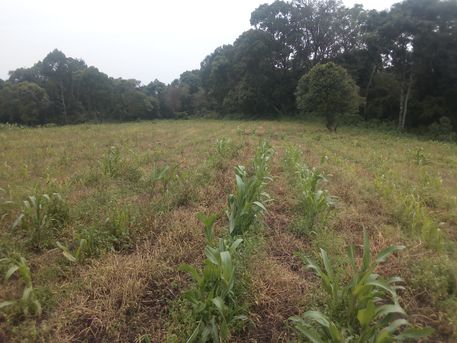I began thinking of sorghum as a viable fodder crop for my animals when I attended an agricultural show in the area. There was a sorghum variety I saw from one of the seed companies that looked quite impressive. It was as tall , if not taller, than the tallest maize crop at the show. It also had a lot of foliage which I figured was good especially for fodder for the cows.

Sorghum growing in the field
I immediately began planning on how to grow the sorghum on the farm. There were many varieties of sorghum, and as I came to find out later, they were not all equal. At the show I actually went to the stand by the company with the impressive variety of sorghum. When I enquired on whether I could purchase some sorghum seed, I was informed that they were all sold out. I couldn't believe it, it was just the second day of the show! I was told that the only way I could try and get seed was to contact the head office. Long story short, it was a long wait before I got the seed.
In the meantime not to be deterred from the dream of sorghum farming as fodder, I decided to try another sorghum variety first. This one was more commonly available and was dual purpose. Could be used as human food and fodder for the cows. I got to planting and the trial begun.
The first sorghum variety did not grow as impressive as the variety I had in mind. It was barely 5 feet tall and had way less foliage than what I thought I would get. It also seemed to get affected bu some sort of disease that would turn the leaves with spotty red marks on the leaves the older the plant grew.
My second trial was a white sorghum variety of sorghum. Still not having got the good variety I was after, I decided to try this “sweet” variety out. I had however been advised that it was better suited for the lower, warmer climate, but the person I was buying from said that it “can” perform well even in my high altitude zone. This did not go well at all. The plant barely got to 3 feet tall and the foliage was very disappointing. This variety I didn't even wait for the second crop. I cut my losses and ploughed it in. the first variety I tried I did let it grow a second time from the cuttings.
There was a sorghum variety I got from a different company that was imported and was sold as a fodder crop. As I was seriously looking into establishing sorghum as the main fodder crop, I tried growing it. It was slightly better than the “sweet” variety but was equally unimpressive as far as height and foliage go. I ploughed this variety after the first harvest.
I finally was able to get the sorghum variety I had seen at the agricultural show almost 3 years before. I however had to call in favors and use a few connections I had to get the seed. Needless to say, it was an expensive affair. The seed cost about 1.5 times the cost of the other types I had tried. I had a lot of hope in this variety and it did not disappoint. It grew quite well compared to the other varieties. Where the soil was fertile enough, the sorghum grew to a minimum of 6 feet tall and had a lot of foliage. From one planting from seed, I usually got about 3 good harvests of crop for making silage. However, the consecutive harvests go reducing. So I usually plough after every 3rd harvest.
The main reason I was willing to pursue sorghum as a fodder crop was that the variety I was after had a lot of foliage. It also was a plus that sorghum grows again from the cuttings left. The one drawback I had read as regards sorghum as a fodder is the possibility of cyanide poisoning. This is especially true if the area the sorghum is grown is hot, or if there is a drought when it is growing.
There is a way to prevent cyanide poisoning in consumption of sorghum as fodder. Ensiling the sorghum greatly reduces(or even eliminates) the risk of cyanide poisoning.
In terms of performance, the dairy cows seemed to do slightly less well when fed on sorghum silage , as compared to maize silage.
Would I grow it again?
I believe the slightly lower energy value of sorghum as compared to maize is offset by the fact that, it can be harvested more than once. The risk of poisoning being eliminated by ensiling means that it is, in my view, worth planting.
I intend to have some sorghum crop as long as I am doing dairy farming.
The other reason I would prefer growing sorghum is that there is plenty of wildlife around that is quite a nuisance. This is especially so for maize. The porcupines and monkeys always know when the crop is just about ready and cant get enough of it! The same is not true for sorghum, which they don't show interest.